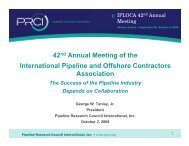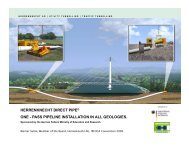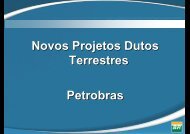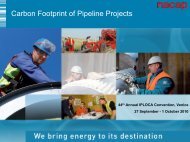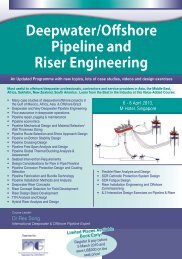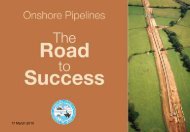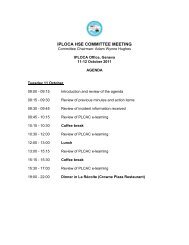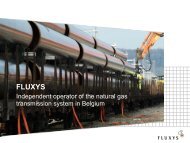EPRG-PRCI-APIA 17th JOINT TECHNICAL MEETING ON ... - Iploca
EPRG-PRCI-APIA 17th JOINT TECHNICAL MEETING ON ... - Iploca
EPRG-PRCI-APIA 17th JOINT TECHNICAL MEETING ON ... - Iploca
You also want an ePaper? Increase the reach of your titles
YUMPU automatically turns print PDFs into web optimized ePapers that Google loves.
<strong>PRCI</strong> Project MATI-7: Alternative to pre-service hydrotest<br />
Over time there have been significant technological advancements in pipeline design, pipe<br />
manufacturing and installation practices. This improved quality management has resulted in<br />
a decrease in hydrotest failures and points towards an alternative approach for<br />
demonstrating pipeline strength. The deliverables from this project will be guidelines for an<br />
alternative to the pre-service hydrotest.<br />
<strong>PRCI</strong> Project PR-269-074505: Influence of pipe material properties on strain demand<br />
This project will describe the stress-strain database, the measures and procedures used to<br />
characterize pipe steel anisotropy, the effects of anisotropy on pipe strain demands, and<br />
how these might be used to guide pipe material specifications with the aim of minimising the<br />
undesirable effects of anisotropy on pipe deformation under strain-controlled loading.<br />
<strong>PRCI</strong> Project ENV-5: Full-scale buried pipe tests to determine and reduce soil loads<br />
on buried pipelines<br />
Previous work identified several areas where further investigations were required to better<br />
define the effectiveness of geofabrics for reducing soil loads. This project will conduct<br />
additional horizontal buried pipe tests to support new recommendations for utilization of<br />
geofabrics, for incorporation in <strong>PRCI</strong>’s seismic design guidance.<br />
<strong>APIA</strong> Project 1.1.2: Understanding hydrostatic testing<br />
Increasing the design factor to 80% SMYS whilst retaining the hydrostatic test factor of 1.25<br />
means that all affected pipelines must be tested to above nameplate strength. Coupled with<br />
this the yield/tensile ratio in high strength pipe can be very high, especially when measured<br />
using tests such as the ring expansion test and when the pipe is coated using processes<br />
such as FBE which cause strain ageing. These circumstances led to concerns that the<br />
available ductility could be diminished or exceeded in volume controlled hydrostatic tests.<br />
A program of testing was undertaken to establish the real strength and ductility of pipe as<br />
manufactured and after coating, and this was supplemented by full scale burst testing. The<br />
behaviour of hydrostatic test sections comprising known strength populations in different<br />
hydraulic gradients was modelled and software was developed that could predict test section<br />
behaviour. The project led to a better awareness of the effect of coating on strength and<br />
toughness properties and of the need to consider this effect in design and specification.<br />
<strong>APIA</strong> Project 1.1.4: Pipeline hydrostatic testing: pressure/temperature correlation<br />
The uncertainty of measurement of temperature affects the accuracy of leak detection in<br />
hydrostatic leak testing. The cost of hydrotesting is also affected by the time taken for<br />
stabilisation of the temperature of the fill water which causes delays before testing can be<br />
undertaken<br />
The project involved a study of the thermal behaviour of a pipeline during filling and<br />
pressurisation and a model was developed to determine longitudinal variations in<br />
temperature. A series of charts were developed that can be used to predict optimum<br />
stabilisation times depending upon starting conditions. Recommendations were also made<br />
for changes to the hydrostatic testing standard including allowing the use of a wider range of<br />
testing fluids for leak detection<br />
<strong>APIA</strong> Project 1.2.8: Low temperature excursions due to operating transients<br />
There is a lack of guidance to industry on prediction of the magnitude of low temperature<br />
excursions that accompany pipeline venting and re-pressurising operations of high-pressure<br />
gas pipelines.<br />
The first phase of the work is concerned with establishment of metal and gas temperatures<br />
in natural gas pipelines during transients. The work comprises a combination of computer<br />
modelling and both laboratory and field measurement including comparison of commonly<br />
used computer simulation programs with physical measurement. The project will establish a<br />
methodology by which the minimum temperatures for pipeline and pipeline component<br />
design can be accurately predicted



